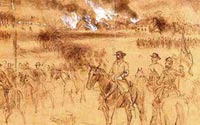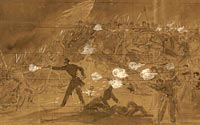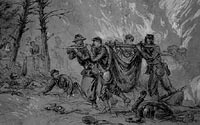A Civil War Sketch Artist

Alfred Waud (1828-1891)
[Custer's Division Retiring from
Mount Jackson in the Shenandoah
Valley, October 7, 1864]
Pencil and opaque white
on tan paper, 1864
![Burning of Mr. Muma's [sic] houses and barns at the fight of the 17th of Sept.](images/vc004874-th.jpg)
Burning of Mr. Muma's
[sic] houses
and barns at the fight
of the 17th of Sept.
Pencil and opaque white on
brown paper, 1862
Prints & Photographs
Division

Attack of the Louisiana
Tigers on a
Battery of the 11th Corps. at
Gettysburg [July 1, 1863].
LC-USZ62-14877, LC-USZC2-3762
Prints & Photographs
Division

Wounded Escaping from
the
Burning Woods in the Wilderness
in Harper's Weekly,
June 4, 1864
Pencil and Chinese White
on paper, 1864
Prints & Photographs
Division
![Reconnoisance [sic.] by Bufords Calvary Towards the Rapidan River](images/at0043.12s-th.jpg)
Alfred R. Waud (1828-1891)
Reconnoisance
[sic.] by Bufords Calvary
Towards the Rapidan River
[published in Harper's Weekly,
October 3, 1863]
Pencil and Chinese white on brown paper,
ca. 1863
Prints & Photographs
Division
Gift of J.P. Morgan, 1919 (43.12)
|
Alfred Waud was recognized as the best of the
Civil War sketch artists who drew the war for the nation's pictorial
press. Waud could render a scene quickly and accurately, with
an artist's eye for composition and a reporter's instinct for
human interest.
At a time when the shutterspeed of cameras was
not fast enough to capture action, the public's only glimpse of
battle came from the sketch artists. Waud's apparent courage under
fire and passion for the men he depicted drew him dangerously
close to the fighting, and his drawings portray more intimately
than those by any other artist the drama and horror of this country's
most devastating conflict.
The first Waud sketch is of Custer's division retiring
from Mount Jackson in the Shenandoah Valley on October 7, 1864.
George Armstrong Custer (1839-76), who lost his life but achieved
immortality at the Battle of the Little Big Horn in June 1876,
first became known for his military exploits on behalf of the
Union army during the Civil War.
He began the war as a second lieutenant assigned
to the Second Cavalry and served at the First Battle of Bull Run,
1861. His efforts during the Peninsular campaign in the spring
of 1862 convinced General George McClellan to add him to his staff,
and by war's end Custer had become one of the most celebrated
and decorated officers in the Northern army.
In the fall of 1864, now a colonel in the regular
army and a major general of the volunteer corps, Custer took over
the Third Cavalry Division in support of the Shenandoah Valley
campaign led by General Philip Sheridan. During the campaign,
Sheridan's men forced Confederate troops from the valley, which
served the South as a major source of produce and provisions,
and proceeded to burn and destroy homes, farms, and fields full
of crops as they returned North.
Custer so distinguished himself during the campaign
that his division was given a prominent role in pursuing General
Robert E. Lee's Confederate army as it fled from Richmond in April
1865. It was Custer who received the Confederate flag of truce
that led to Lee's surrender at Appomattox Courthouse on the morning
of April 9.
|

